

In the early 2000s Subaru released its variable camshaft timing system. It was introduced as a measure to improve torque, reduce emissions, and improve drivability for the EJ series motors.
Active Valve Control System, or AVCS for short, is an ECU controlled, hydraulically operated, adjustable camshaft gear. By advancing or retarding the camshaft timing, Subaru engineers can alter the moment the valves opened relative to engine load. This can improve engine power, improve fuel economy, and reduce emissions.
Single AVCS adjusts only the intake camshafts.
Dual AVCS adjusts both the intake and exhaust camshafts, independently.
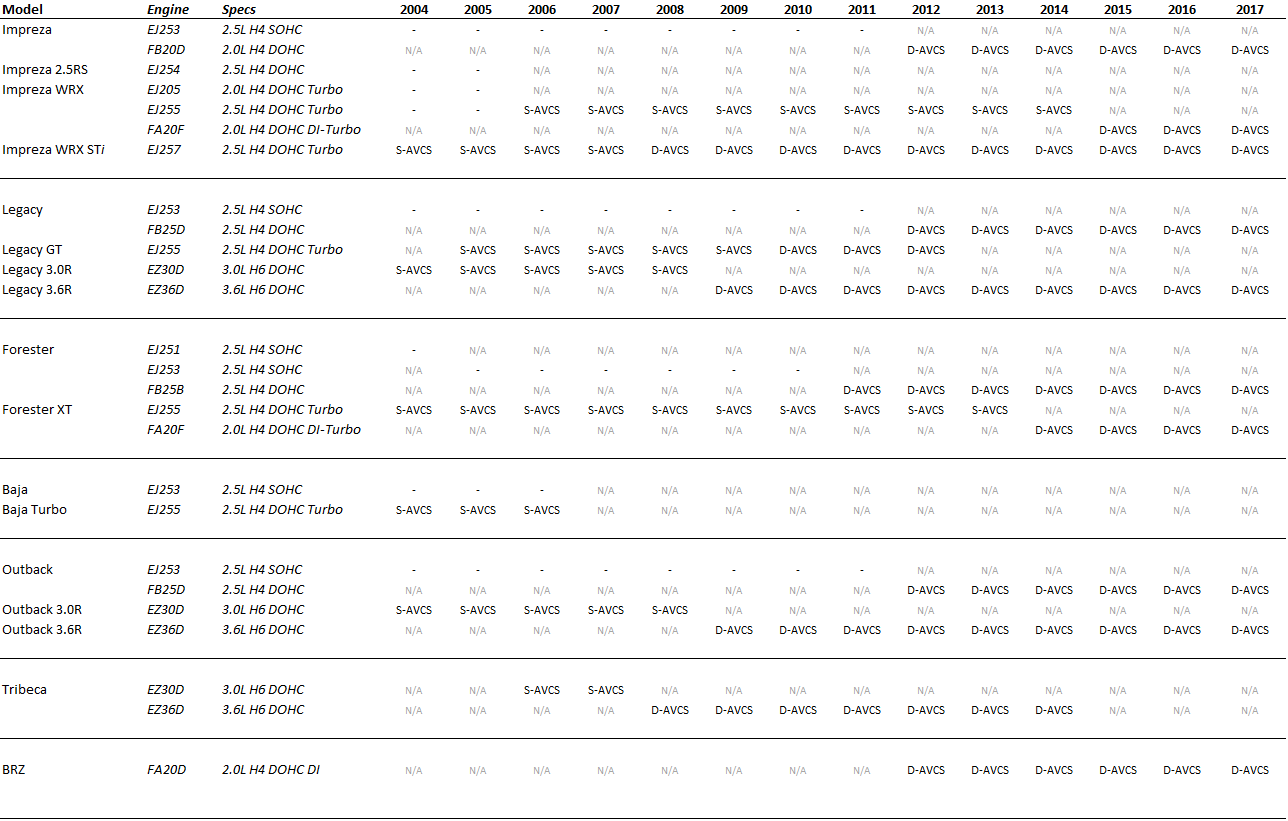
List of Subaru Engines with AVCS
Click on the above image for a list of Subaru models (North America) from 2004 to 2016
Subaru's AVCS is not the same as Honda's VTEC.
VTEC runs 3 camshaft lobes per set of valves instead of the normal 2 lobes on an EJ20 / EJ25 motor. At a set RPM, the VTEC solenoid opens and uses oil pressure to engage a 3rd rocker arm. The 3rd rocker is what forces the "high cam" profile on the intake side (SOHC VTEC) or intake and exhaust side (DOHC VTEC). This allows engines like the B18C5 (Integra Type-R) to effectively use a lower duration, low-lift camshaft profile at low RPM, but switch over to a high duration, high lift profile at higher RPM. The AVCS system uses the same camshaft profile throughout the entire RPM range.
Honda's i-VTEC incorporates both cam phasing and traditional DOHC VTEC operation. This technology is what makes the K-series (K20A2 / K20Z3) engines produce considerably better low-end torque compared to the older B-series motors. The cam phasing functionality of i-VTEC is similar to AVCS.
Subaru's AVLS (Active Valve Lift System) is, however, similar to VTEC.
The ECU uses sensory data such as throttle position, coolant temperature, intake air metering, and camshaft position to determine the optimal amount of cam phasing. The ECU then sends a signal to the oil control valve which operates within a poppet cylinder to regulate oil flow into the actuator. The high oil pressure then enters the camshaft actuator to adjust cam angle by rotating the interior rotor. This causes the camshaft to rotate to either an advanced or retarded position.

Subaru AVCS Cam Gear
This is an image of the cam actuator inside of the AVCS cam gear in various positions. It illustrates how the internal rotor can rotate to adjust camshaft position.
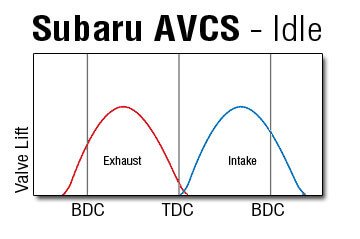
At idle the camshafts are zeroed out for a smooth idle
At idle conditions the AVCS system is dormant and provides no advance or retard. However, the AVCS can be engaged to help smooth out a rough idle due to aftermarket camshaft profiles. Care should be taken to avoid this due to the systems low oil pressure at idle. The reason for the smooth idle is the minimal amounts of overlap produced by the OEM camshafts. The lack of significant overlap promotes stability in the chamber by opening the intake valve after top-dead-center (TDC) to ensure sufficient chamber conditions.
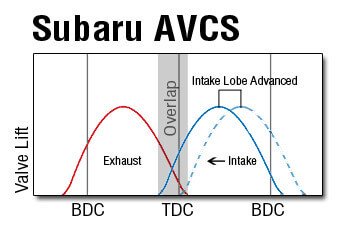
Advancing the intake cam produces an overlap moment and increased dynamic compression
At low to moderate engine load a single AVCS system will begin to advance the intake camshaft. As the rotor advances it will open the intake valves sooner which causes reversion of exhaust gasses into the intake manifold. This cools the combustion chamber by reducing the energy of the next combustion cycle, thus reducing nitrogen oxide(s), (NOx), from being formed.
Since the valve is opened early, the intake valve will also close sooner. Closing the intake valve earlier creates a higher dynamic compression ratio. This improves torque production, fuel economy, and turbo response.
At full load the AVCS system will reach a point of full advance in the midrange and slowly reduce the amount of advance as engine RPM rises towards the rev limit. At full advance the chamber begins to see a weak scavenging effect due to exhaust pulse timing. This effect relies upon the negative pressure wake of the exhaust pulse in conjunction with an overlap moment to assist the intake charge entering the chamber (improving mass flow). The early valve closing also produces significantly higher dynamic compression which helps torque production but can increase the chances for detonation.
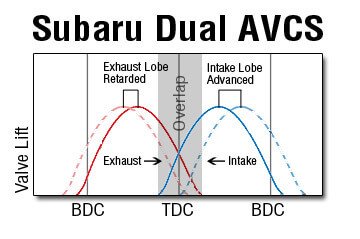
Dual AVCS advances the intake camshaft while also retarding the exhaust camshaft
Dual AVCS can independently adjust the intake and exhaust camshaft phase, allowing for more overlap moment and better control over the RPM range
As mentioned earlier, dual AVCS (or D-AVCS) allows the ECU to adjust the intake and exhaust camshafts independently. This allows for a couple advantages over single AVCS (S-AVCS) such as:
On turbo cars valve overlap can have wildly varying effects depending on the RPM and the pressure differential between the intake port and exhaust port. Agnostic of resonance and pulse timing the pressure difference relies on intake manifold pressure and the backpressure in the exhaust manifold pre-turbine. The exhaust side pressure varies depending on several factors, including:
As you can see, this is a very dynamic situation. Here is a simplified graph to show you some trends in different setups and how exhaust side pressure varies.

EJ257 Exhaust Manifold Pressure
As the exhaust side pressure nears a 1:1 ratio with boost pressure then overlap will have a more beneficial effect. Otherwise, on a stock VF turbo its best to avoid overlap at WOT beyond 3000 RPM as this will cause reversion and dilute the incoming mix, reducing power.
At cruising and non-WOT conditions the exhaust cam timing can be retarded which induces an EGR (exhaust gas recirculation) effect in certain RPM ranges. This reduces incoming emissions, cools the combustion temperature, slows the burn rate, and improves fuel economy by reducing the amount of air:fuel mixture that enters the chamber and small tuning adjustments.
By allowing the valve timing to be adjustable on demand, the dual AVCS system gives engineers the ability to run a camshaft profile that is more suitable to a certain RPM range. The AVCS is then used to widen the torque plateau or improve performance elsewhere. While its certainly less effective than VTEC, it is a beneficial tool to have.
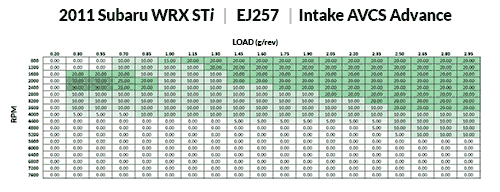
Stock Intake AVCS Advance Map - 2011 STI (EJ257)
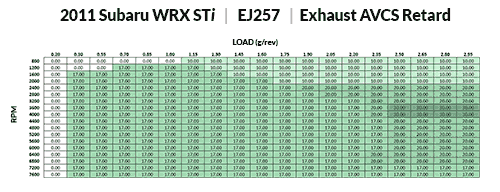
Stock Exhaust AVCS Retard Map - 2011 STI (EJ257)
Preventing Subaru Ringland Failure in the WRX, STI, etc.
Detonation and Knock Explained | Causes and Prevention
Subaru Equal vs. Unequal Length Headers
Car Overheating? Learn to Diagnose, Fix, and Prevent It
We are constantly looking for new content ideas and feedback from the community. Head over to our contact page and send us an email with your ideas, comments, or questions.

Join our email list to be notified when we release new content.
We respect your inbox and send only 1 - 4 emails per month.
We will never spam, sell, or do annoying things with it ... ever.